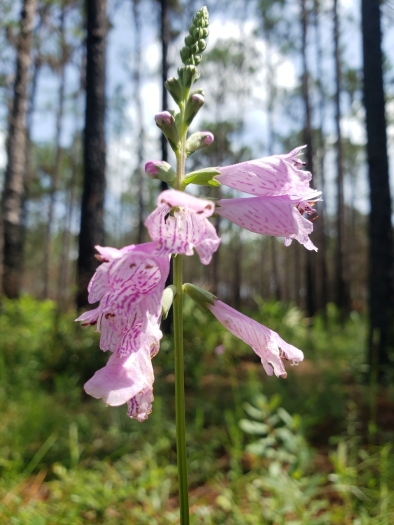Obedient Plant
(Physostegia purpurea)
Obedient Plant (Physostegia purpurea)
/
/

Valerie Anderson
CC BY 4.0
Image By:
Valerie Anderson
Recorded By:
Copyright:
CC BY 4.0
Copyright Notice:
Photo by: Valerie Anderson | License Type: CC BY 4.0 | License URL: http://creativecommons.org/licenses/by/4.0/ | Rights Holder: Valerie Anderson | Publisher: iNaturalist | Date Created: 2020-05-30T11:20:12-07:00 |































Estimated Native Range
Summary
Physostegia purpurea, commonly known as Obedient Plant or Eastern False Dragonhead, is a deciduous perennial herb native to moist meadows, stream banks, and wet prairies in the Southeastern United States. It typically grows to a height of 1-3 feet (0.3-0.9 meters) and a width of up to 2 feet (0.6 meters). The plant features upright, square stems with lance-shaped leaves and produces dense spikes of tubular flowers that are pink to purple in color, blooming from late summer to early fall. The flowers are particularly showy and can add a vertical accent to garden borders.
The Obedient Plant is valued for its long-lasting blooms and ability to attract pollinators such as bees and butterflies. It is often used in perennial borders, native plant gardens, and as a cut flower in arrangements. This plant thrives in full sun to part shade and prefers moist, well-drained soils, although it can tolerate periods of drought once established. It is relatively low maintenance but can spread aggressively by rhizomes, so it may require control measures to prevent it from overtaking other plants. Potential problems include powdery mildew and leaf spot diseases.CC BY-SA 4.0
The Obedient Plant is valued for its long-lasting blooms and ability to attract pollinators such as bees and butterflies. It is often used in perennial borders, native plant gardens, and as a cut flower in arrangements. This plant thrives in full sun to part shade and prefers moist, well-drained soils, although it can tolerate periods of drought once established. It is relatively low maintenance but can spread aggressively by rhizomes, so it may require control measures to prevent it from overtaking other plants. Potential problems include powdery mildew and leaf spot diseases.CC BY-SA 4.0
Plant Description
- Plant Type: Herb
- Height: 1-3 feet
- Width: 0.167-0.5 feet
- Growth Rate: Moderate
- Flower Color: Pink, Purple
- Flowering Season: Spring, Summer
- Leaf Retention: Deciduous
Growth Requirements
- Sun: Full Sun, Part Shade
- Water: Medium
- Drainage: Slow, Medium
Common Uses
Bee Garden, Bird Garden, Butterfly Garden, Deer Resistant, Hummingbird Garden, Low Maintenance, Showy Flowers, Water Garden
Natural Habitat
native to moist meadows, stream banks, and wet prairies in the Southeastern United States
Other Names
Common Names:
Scientific Names: , Physostegia purpurea, Dracocephalum purpureum, Physostegia obovata, Dracocephalum obovatum, Physostegia virginiana var. obovata, Prasium purpureum,
GBIF Accepted Name: Physostegia purpurea (Walter) S.F.Blake